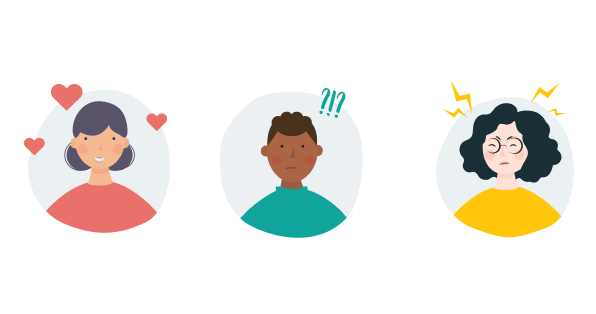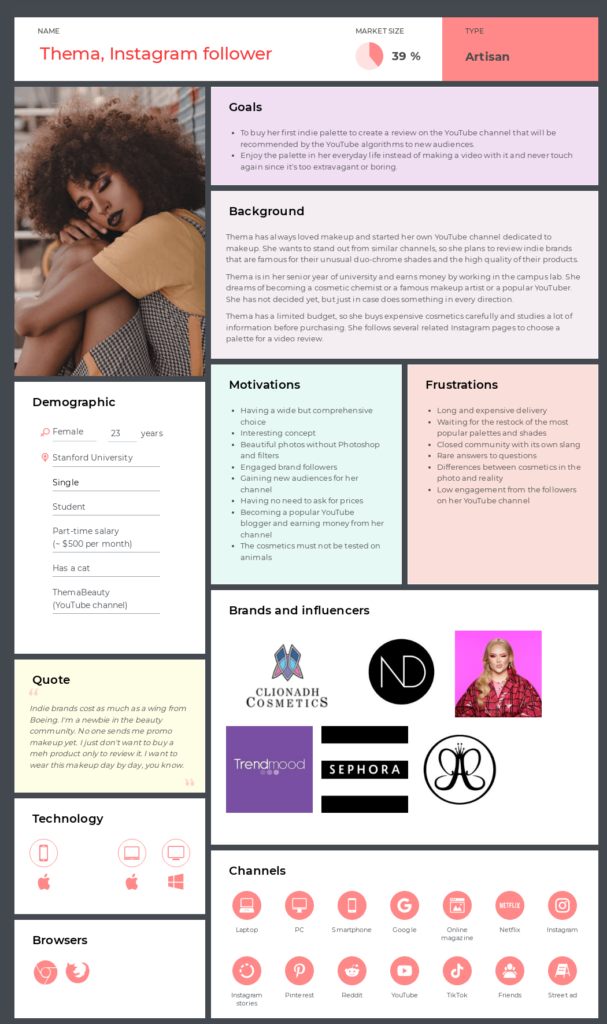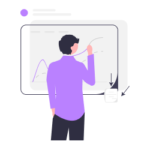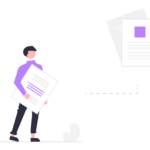Running after two rabbits, you will catch neither. Now imagine there are thousands or millions of rabbits to chase. How to save energy, time, and not be left empty-handed? Surround a certain part of the eared fluffies and offer them the desired variety of carrots. It’s something we call grouping or segmentation. And you can use it to pursue your customers, too.
There are many methodologies for classifying and dividing the audience. And some of those are seemingly interchangeable, like a persona and market segment. After all, both represent people who use your service or product or buy something from you. And both can be the heart of a business or marketing strategy.
Yet “seem” is the key word. If you dig deeper, it turns out that personas and segments are not only different approaches to group your customers but also serve different purposes. So grab a shovel and let's dig.
Contents
Persona vs. market segment: WHAT

So why don't we begin with definitions?
Market segmentation is a strategic tool that involves splitting the market into separate parts and approaching each in a fitting manner. Within such parts or segments, there will be people who are homogeneous in some ways. Being guided by the shared characteristics of such groups, businesses can save resources, target audiences more accurately, and ultimately thrive.
A persona is a tactical tool that helps a business see itself through the eyes of its target audience and saturates the team with empathy for customers, dividing them into characters with shared demographic and/or behavioral patterns.
Personas feel like real people while representing a bunch of customers. A market segment is more about a faceless crowd.
Persona vs. market segment: WHICH

Each way of target audience grouping has its own nuances and criteria to narrow your focus. And narrowing focus is always handy when it comes to developing, creating, or promoting a product or service.
When using market segmentation, you can divide customers by the following characteristics:
- Demographic (e.g., age, gender, income, family size)
This segmentation type may help to find out who buys from you and, based on this knowledge, divide the market. For instance, you have a publishing house and, after collecting data about your audience, see that your typical buyers are school girls and adult men with high incomes. From now on, you are going to publish more young adult series for the first group and business literature for the second, promoting each within its own segment. After all, why spend money advertising success stories to adventurous teenagers?
- Psychographic (e.g., social class, lifestyle, personality type)
This type prioritizes your customers’ interests and inclinations instead of their income or, say, marital status. Let's say you create branded t-shirts. Knowing the audience's favorite music bands, you will target ads for each of them with specific prints that match their preferences. Or, for example, being a travel company, you can offer social outdoor activities to the more extroverted part of your audience. While for introverted people, these would be individual excursions and secluded hotels.
- Behavioral (e.g., loyalty state, purchase reason, motivations)
This way of segmenting your customers is about their interaction with your business. It helps you target the most engaged people, increasing marketing campaigns' effectiveness and audience engagement. For example, you send information about a new collection of fragrances to your regular customers who have a loyalty card with a high discount percentage and who often open your emails. What is the probability that this strategy will work? The odds are high.
- Geographic data (e.g., location, city size, climate, population density)
Knowing where your audience is located helps tailor your marketing initiatives to where customers live, shop, see street banners, travel, and so on. This segmentation is also entwined with a cultural code which provides lots of insights useful for business strategies.
For instance, buyers of farm products can be divided into those who live close to the farm and come for the goods themselves, those who are used to buying products in the markets, and those who live in the cities and will only be able to get your products through delivery. Each of these market segments requires its own advertising and further approach. And knowing the cultural characteristics of different regions, you can competently address the localization of your business name so as not to get into trouble. You may choose a popular color scheme for design and even launch a certain flavor line (for example, the spiciest chips will go well in Thailand).
Sometimes you’d want to combine different market segmentation types to hit even smaller parts of your target audience. With personas, no crossovers are possible.
Persona grouping types depend on who your “customers” are and whose experience you want to address:
- Buyers;
- Users;
- Employees;
- Etc.
Below we are going to unveil some of these persona types through various business cases.
Buyer personas
If you are selling products or services, you will inevitably encounter buyer or user personas. What’s the difference? The buyer personas are directly involved in the buying process as decision-makers, while the user personas may buy nothing from you and still consume your production. For example, a child receives a phone from a parent as a gift, or a company buys licenses to use a platform found by a certain employee who was the buyer persona.
Identifying these personas will help you better understand the people you are creating a product or service for. You will learn their motivations, pain points, goals, desires, and needs. And, based on this data, you will figure out not only how to approach a certain group of your customers but also how to make your relationships last through a pleasant experience.
Let’s say you know that some coffee drinkers visit you on their way to work — they are often late, sleep on the go, and feel moody. Having studied their goals, motivations, frustrations, preferences, and challenges, you can act. Turn down the music and open three cash desks instead of one in the morning. Offer regular customers pre-order their drinks, and treat those who wish to have a free espresso while they are waiting in line. As a result, your coffee shop becomes the best place for a target persona, and their satisfaction grows, as well as your profit since they come back over and over again.
User personas
If you run an online business, it's important to research your digital customers. Their experience differs from offline customers, and by studying your digital audience, you can learn more about people who use your websites, applications, online tools, etc., to design or redesign interfaces, create relevant content, and optimize user journeys.
Employee personas
If you want to get an insight into your own team, you will need to create employee personas. Your staff can be grouped by job role, duration of work in the company, location (remote employee vs. office workers), etc.
Turning your colleagues into personas allows you to make point changes in the experience of the people you work with. Improving the employee experience increases the motivation, engagement, and functioning of your business as a whole.
For example, knowing about the churn among newcomers, you can identify and eliminate the problems they face. Thereby you will increase the percentage of those who go through the onboarding phase without forcing the company to spend resources again on finding new employees.
All in all, having reviewed the market segments’ and personas’ types in detail, we see more clearly that market segmentation helps to find and target a niche, while persona profiles are great for zooming in on this niche.
Persona vs. market segment: WHY

How can personas and market segments be useful to your business, besides the fact that you distribute resources more competently and more precisely approach your customers? Why use these tools at all? It’s time to find it out.
Adopting market segmentation brings great potential to a business:
- Improving your marketing campaign performance
Your advertising messages become clearer to the target audience and are addressed to those who are ready to hear them. This also leads to an increase in the open rate of your emails, banner clicks, lead conversions, customer retention, etc. Let’s imagine you promote a soda drink. You narrow your focus to the teen gamers, combining demographic and psychographic segmentation types. Then put some geek stuff into your advertisement for this segment to hear you out and associate the promoted drink with their hobby. And the odds are they will.
- Dividing product lines to better fit different market segments
You are positioning your product for people with an upper average income, but sales aren’t encouraging. After studying the audience, you understand that people in the target segment have certain requirements for packaging, while yours doesn’t meet those. It turns out that you either need to change the target segment or tailor your product or launch separate product two lines for middle and premium segments.
- Finding out new market opportunities
While segmenting your audience, you may notice that some segments require more attention. Paying more attention to those may help to increase your presence in the global market and open up new horizons. Say you have always been targeting young adults when promoting video games, but after researching the target audience, you see there are older people who might be interested in it, while you never focus on them in the advertising campaigns.
- Narrowing your focus to optimize efforts and costs
With the help of the segmentation, you will see which segments are fine and require no extra effort from you and which ones have the potential for growth. Most of all, this will help businesses with small advertising budgets because targeted marketing campaigns will bring more leads.
- More efficient lead generation
With personalized offers and messages, you'll more accurately hit your audience's pains. As a result, your leads will be more likely converted into customers.
Promising much, but personas can be as beneficial to your business as market segmentation. Those help to take a piece of the market pie and turn it into something smaller, or rather someone, ‘cause personas let you see not the crowd but a personality that might be interested in your product or service.
See for yourself:
- Matching your products with customers’ goals
This means you don’t look for people who happen to fit your target audience, you learn what your customers want and give it to them. Thus, customer loyalty, satisfaction, and retention grow. It’s also extremely beneficial at the MVP phase since it helps to save money and effort.
- Using the persona’s expectations to surprise them when they expect nothing good and not to fall face down in the dirt in the opposite cases
When you know not only who your consumers are but what they have experienced before, it becomes easier to understand what kind of pain it’s better to reach them through in advertising or email. You see what mistakes you need to avoid 100% and how you can please customers in contrast to their previous background. For example, you are engaged in home delivery of groceries, and you know that your persona hasn't had a chance to choose food via video call, while the delivery is flexible and the couriers worked even at night. You understand that without round-the-clock delivery, you will be uncompetitive, but video communication will become your wow factor. Acting under this information, you will win your persona’s heart.
- Starting speaking your customers’ language
Sometimes you want to impress your customers by using intricate metaphors or complex technical information, or vice versa by chewing on material for experts. Leveraging the persona vocab, you will understand what phrases are best to get your point across. And what style to choose for your digital resources to attract and convert more leads.
- Facilitating your communication with the target audience
When you leverage your persona’s channels, it becomes easier to interact.
For instance, you have a blog full of outstanding articles on Medium, while your persona never reads this platform but loves receiving expert content via email. Or you offer your clients to call you 24/7, but they prefer writing in the chat. Such a minor detail may cause overall dissatisfaction. And vice versa, being more accessible is a way to win your audience’s hearts.
- No more experimenting in vain and wasting budgets
Sometimes business decisions are based on assumptions, but it only seems that you know your audience by default. Having complete and reliable information about your customers it’s easier for you to come up with marketing strategies, position yourself in the market and manage customer experience.
- Going further by improving customer, user, buyer, or employee experience
Persona profiles can become a runway for a deeper understanding of your audience with the help of a customer journey mapping methodology. Building a journey map, you will get insights into persona experience, which plays a significant role in any business nowadays.
What conclusion can we come to after looking at the perspectives of each tool?
Market segmentation will be a great help when you already have a certain strategy and need to decide which segment it will be applied to. Or when you’re going to launch a product and want to find the perfect niche to promote it inside.
Persona creation is useful at the initial stages of product development, for its redesign in case of unsuccessful market entry, and also to learn more about the already gained audience and their needs, wants, and jobs to be done. Put another way, the market segment is like a phone to reach your audience with, while the persona profile is the language you need to speak to keep your conversation going.
And it’s always up to you what tool fits your case better.
Persona vs. market segment: HOW

Already inspired and can’t wait to try market segmentation or persona creation? Then let's figure out what steps you need to take for this.
To develop a market segment, follow these steps:
Step 1. Start by defining your market and collect information about your current or potential customers through market research.
Step 2. Now scope and analyze the audience that responds to similar fluctuations in the market and similar marketing strategies.
Step 3. Put your strategy into action.
Step 4. Review the target segment’s reactions and draw conclusions.
Step 5. Tweak your strategy if needed. And repeat until you get the desired results.
Sounds like an immense piece of work? Wait until you hear how to create personas. Yet no worries, it's worth it.

And here’s what you have to do:
Step 1. Conduct research. You can't go further without real data, so collect relevant information about real people buying from you.
Step 2. Set some attributes to divide your customer by. We usually suggest sticking with the behavioral ones. This way, you will understand the reasons behind buyers’ actions and thoughts.
Step 3. Define the personas. The more often a certain pattern occurs, the stronger the signal that this is a persona. And yes, there can be many.
Step 4. Create detailed persona profiles that feel real. Combine demographic and behavioral data and sprinkle it all with visual elements.

Step 5. Act on it.
Wrapping up
We considered two different approaches to audience grouping, understood what they have in common, how they differ, and in what business cases, which one will be more useful.
When you need to promote a product or service that perfectly fits certain market segments, this tool might be all you need to succeed. But if you have the resources to aim as accurately as possible and run a marathon in your customer's shoes, do it. Personas enrich and detail your market segments, humanize those, evoke empathy in your team and show themselves as people instead of numbers and diagrams.
A combination of market segmentation and persona development is what can set you apart from the competition in the battle over customers’ hearts, be it a new product launch, some product development initiative, or a website redesign.






Persona vs. Market segment feels like a solid battle (and I’ve seen people that couldn’t tell a marketing persona from segment), but you’re right, both methods are better to be combined.
Never considered persona vs. market segment as a holywar, more like the partners in the know-your-audience crime. Good to know it’s not a wrong approach.